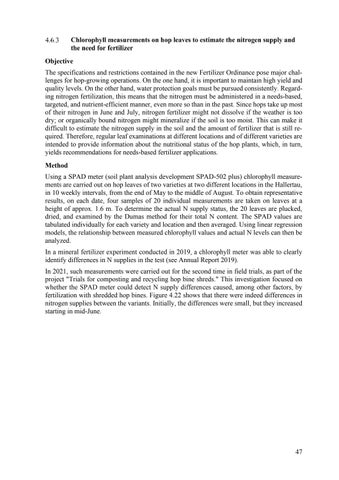Objective The specifications and restrictions contained in the new Fertilizer Ordinance pose major challenges for hop-growing operations. On the one hand, it is important to maintain high yield and quality levels. On the other hand, water protection goals must be pursued consistently. Regarding nitrogen fertilization, this means that the nitrogen must be administered in a needs-based, targeted, and nutrient-efficient manner, even more so than in the past. Since hops take up most of their nitrogen in June and July, nitrogen fertilizer might not dissolve if the weather is too dry; or organically bound nitrogen might mineralize if the soil is too moist. This can make it difficult to estimate the nitrogen supply in the soil and the amount of fertilizer that is still required. Therefore, regular leaf examinations at different locations and of different varieties are intended to provide information about the nutritional status of the hop plants, which, in turn, yields recommendations for needs-based fertilizer applications. Method Using a SPAD meter (soil plant analysis development SPAD-502 plus) chlorophyll measurements are carried out on hop leaves of two varieties at two different locations in the Hallertau, in 10 weekly intervals, from the end of May to the middle of August. To obtain representative results, on each date, four samples of 20 individual measurements are taken on leaves at a height of approx. 1.6 m. To determine the actual N supply status, the 20 leaves are plucked, dried, and examined by the Dumas method for their total N content. The SPAD values are tabulated individually for each variety and location and then averaged. Using linear regression models, the relationship between measured chlorophyll values and actual N levels can then be analyzed. In a mineral fertilizer experiment conducted in 2019, a chlorophyll meter was able to clearly identify differences in N supplies in the test (see Annual Report 2019). In 2021, such measurements were carried out for the second time in field trials, as part of the project "Trials for composting and recycling hop bine shreds." This investigation focused on whether the SPAD meter could detect N supply differences caused, among other factors, by fertilization with shredded hop bines. Figure 4.22 shows that there were indeed differences in nitrogen supplies between the variants. Initially, the differences were small, but they increased starting in mid-June.
47













